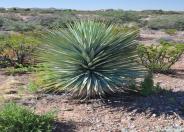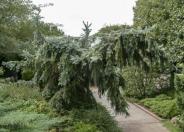
Common name:Coral Aloe
Botanical name:Aloe striata
More attractive than saponaria. Great flower display in late winter. A slow to moderate grower forms a large rosette. Fleshy leaves are pale gray and broad at the base. Leaves have fine longitudinal lines and also pink margins. Clusters of flowers are coral red to orange on 3' stalks. South African native. Best with filtered sun. Frost tender but more cold hardy than saponaria.

Common name:Blue Yucca
Botanical name:Yucca rigida
Evergreen treelike yucca grows at a moderate rate to 12' x 5'. Distinctive, blue gray leaves have sharp tips. Striking bluish color makes it a great accent. White clusters of flowers appear on tall stalks late spring to summer. Accepts full sun. Native to the Chihuahuan Desert in Mexico.

Common name:Century Plant, Maguey
Botanical name:Agave americana
Fast growing to about 6-10' tall x 8-13' wide. Wide, grey leaves have stiff terminal spines and recurved teeth on margins. Prefers full sun and well-drained situations. Prone to agave snout weevil which will eat the roots and heart out. After blooming, which could take several years. it will die but will send up new pups from around the base. Some people are allergic to the sap. Removal is difficult if unwanted.

Common name:Weeping Colorado Spruce
Botanical name:Picea pungens 'Pendula'
Picea pungens 'Pendula' is broadly spreading selection of Colorado spruce with lax, strictly weeping lateral branching. If not staked, this conifer rambles along the ground. The branches just hang limply down creating a pole like appearance with the bottom branches creeping across the ground. It is a robust growing plant, with terminal buds extending 1 foot or more on a yearly basis. Ultimate height is determined by the height of the stake used to support the young plant. Needles are bright Blue that fade to dark green in their second year. Internal and shaded foliage is also more green than blue in color.
Designer: Linda McSwain (retired)
Photographer: Vicki Anderson
Maintain a two to four inch layer of mulch on the soil surface to reduce weeds, infiltrate rain water, and reduce compaction.
Remove irrigation water and fertilizer from areas where you don't want weeds to grow.